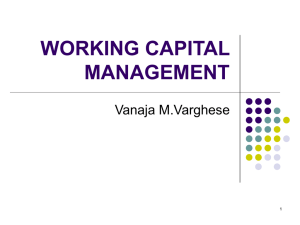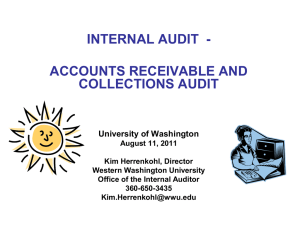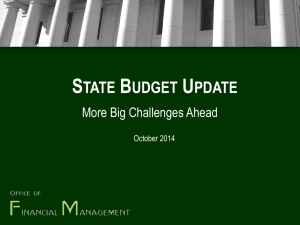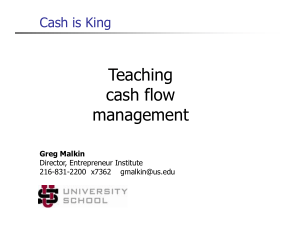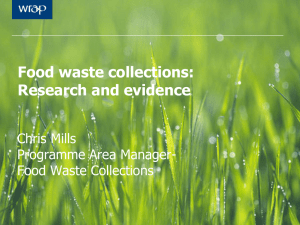Working Capital, PowerPoint Show
advertisement
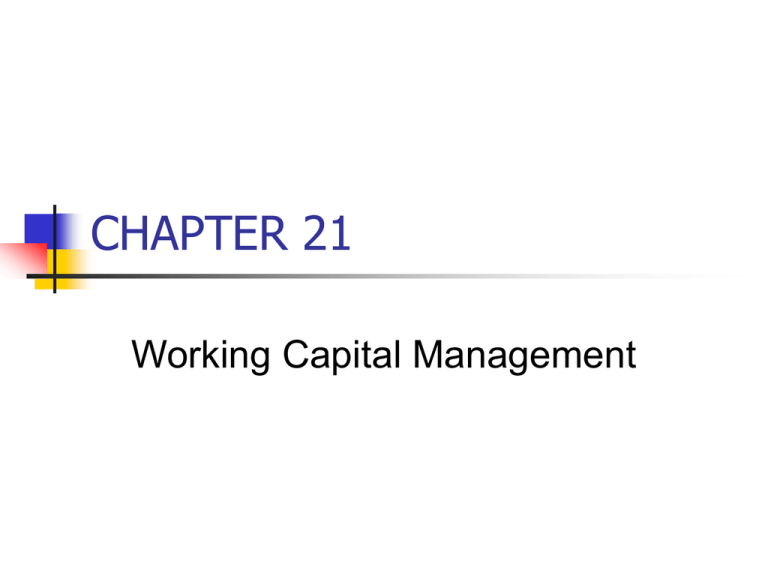
CHAPTER 21 Working Capital Management Topics in Chapter • • • • • Working capital policies Cash, inventory, and A/R management Accounts payable management Short-term financing policies Bank debt and commercial paper 21-2 Basic Definitions • Gross working capital: Total current assets • Net working capital (NWC): Current assets - Current liabilities • Net operating working capital (NOWC): Operating CA – Operating CL = (Cash + Inv. + A/R) – (Accruals + A/P) 21-3 Working Capital Management • Day-to-day control • • • • • Cash Inventories Accounts receivable Accruals Accounts payable • Working capital policy • The level of each current asset • How current assets are financed 21-4 Cash Conversion Cycle The time between payments made for materials and labor and payments received from sales: (21-4) Cash Inventory Receivables Conversion = Conversion + Collection − Cycle Period Period Payables Deferral Period 21-5 Inventory Conversion Period • Average time required to convert materials into finished goods and to sell those goods: Inventory InventoryConversionPeriod Sales per day 21-6 Receivables Collection Period • Average length of time required to convert the firm’s receivables into cash: Receivables Receivables Collection Period Sales / 365 Receivables Collection Period = DSO = Days Sales Outstanding 21-7 Payables Deferral Period • Average length of time between the purchase of materials and labor and the payment of cash for them: Payables Payable DeferralPeriod Purchasesper Day Payables Cost of goodssold / 365 21-8 Real Time Computer Cash Conversion Data Real Time Computer Company Sales $10,000,000 annual COGS $8,000,000 annual Inventories $2,000,000 average AR $657,534 average AP $657,534 average Days/year 365 21-9 Inventory Conversion Period Real Time Computer Company Sales $10,000,000 annual COGS $8,000,000 annual Inventories $2,000,000 average AR $657,534 average AP $657,534 average Days/year 365 Inventory Sales per day $2,000,000 InventoryConversionPeriod 73 days $10,000,000 / 365 InventoryConversionPeriod 21-10 Receivables Collection Period Real Time Computer Company Sales $10,000,000 annual COGS $8,000,000 annual Inventories $2,000,000 average AR $657,534 average AP $657,534 average Days/year 365 Re ce ivables Sale s / 365 $657,534 Re ce ivables Colle ctionPe riod 24 days $10,000,000 / 365 Re ce ivables Colle ctionPe riod 21-11 Payables Deferral Period Real Time Computer Company Sales $10,000,000 annual COGS $8,000,000 annual Inventories $2,000,000 average AR $657,534 average AP $657,534 average Days/year 365 Payable s Purchas e spe r Day Payable s Cos t of goodss old / 365 $657,534 30 days $8,000,000 / 365 Payable De fe rralPe riod 21-12 Cash Conversion Cycle Cash Inventory Receivables Payables Conversion = Conversion + Collection − Deferral Cycle Period Period Period CCC = 73 days + 24 days – 30 days CCC = 67 days (21-4) 21-13 Cash Conversion Cycle Figure 21-1 21-14 Cash Conversion Objective • Shorten the cash conversion cycle as much as possible without hurting operations: • Reduce Inventory Conversion period • Process & sell goods quicker • Reduce Receivables Collection period • Speed up collections • Lengthen Payables Deferral Period • Slow firm’s payments 21-15 Real Time Computer TABLE 21.1 21-16 Real Time Computer Original $10,000,000 8,000,000 Improved 10,000,000 8,000,000 73 24 30 67 65 23 31 57 $2,000,000 657,534 657,534 $1,780,822 630,137 679,452 Net operating working capital (NOWC) $2,000,000 Improvement in FCF = Original NOWC - Improved NOWC $1,731,507 $268,493 Annual sales Costs of goods sold (COGS) Inventory conversion period (days) Receivables collection period (days) Payable deferral period (days) Cash conversion cycle (days) Inventorya Receivablesb Payablesc Notes: a Inventory = (Inventory conversion period)(Sales/365) b Receivables = (Receivables collection period)(Sales/365) c Payables = (Payables deferral period)(Sales/365) 21-17 Alternative NOWC Policies Cash & Inventory Holdings Credit Policy Receivables Payables & Accruals Restricted Minimum Tight Minimum Maximum Moderate Moderate Moderate Moderate Moderate Large Liberal Large Minimum Aggressive 21-18 Cash Management: Cash = “Non-earning Asset” • Transactions: • Must have some cash to pay current bills. • Precautionary balances = “Safety stock” • Compensating balances: • For loans and/or services provided. • Speculation: • Take advantage of bargains • Take discounts 21-19 Cash Budget: The Primary Cash Management Tool • Projected cash inflows, outflows, and ending cash balances forecast loan needs and funds available for temporary investment • Daily, weekly, or monthly, depending upon budget’s purpose • Monthly for annual planning • Daily for actual cash management 21-20 Data Required for Cash Budget • Sales forecast • Information on collections delay • Forecast of purchases and payment terms • Forecast of cash expenses: wages, taxes, utilities, and so on • Initial cash on hand • Target cash balance 21-21 MicroDrive Cash Budget Input Data Collections during month of sale Collections during 1st month after sale Collections during 2nd month after sale Discount on first month collections Purchases as a % of next month's sales Lease payments Construction cost for new plant (Oct) Target cash balance Sales adjustment factor 20% 70% 10% 2% 70% $15 100 $10 0.00 21-22 THE CASH BUDGET May Collections and purchases worksheet Sales (gross) Collections During month of sale - 2% discount During first month after sale During second month after sale Total collections $200 Purchases 70% of next months sales Payments on last month's purchases Cash gain or loss for month Collections Payments for purchases Total Other Expenses Taxes Payment for plant construction Total payments Net cash gain (loss) during month Loan requirement or cash surplus Cash at start of month if no borrowing Cumulative cash Target cash balance Cumulative surplus cash or loans outstanding to maintain $10 target cash balance Jun $250 $210 Jul Aug Sep Oct Nov Dec $300 $400 $500 $350 $250 $200 59 $175 $20 $254 78 $210 $25 $313 98 $280 $30 $408 69 $350 $40 $459 49 $245 $50 $344 39 $175 $35 $249 $280 $210 $350 $280 $245 $350 $175 $245 $140 $175 $140 $254 210 55 $313 280 70 $408 350 85 30 $459 245 70 $344 175 55 $249 140 55 20 $265 ($11) $350 ($37) $465 ($57) 100 $415 $44 $230 $114 $215 $34 $ 15 $4 $10 $4 ($33) $10 ($33) ($90) $10 ($90) ($46) $10 ($46) $68 $10 $68 $102 $10 ($6) ($43) ($100) ($56) $58 $92 Table 21-2 21-23 May Collections and purchases worksheet Sales (gross) Collections During month of sale - 2% discount During first month after sale During second month after sale Total collections $200 Purchases 70% of next months sales Payments on last month's purchases Cash gain or loss for month Collections Payments for purchases Total Other Expenses Taxes Payment for plant construction Total payments Net cash gain (loss) during month Loan requirement or cash surplus Cash at start of month if no borrowing Cumulative cash Target cash balance Cumulative surplus cash or loans outstanding to maintain $10 target cash balance Jun $250 $210 Jul Aug $300 $400 59 $175 $20 $254 78 $210 $25 $313 $280 $210 $350 $280 $254 210 55 $313 280 70 $265 ($11) $350 ($37) $ 15 $4 $10 $4 ($33) $10 ($6) ($43) 21-24 Input Data Collections during month of sale Collections during 1st month after sale Collections during 2nd month after sale Discount on first month collections Purchases as a % of next month's sales Target cash balance 20% 70% 10% 2% 70% $10 THE CASH BUDGET May Jun Collections and purchases worksheet Sales (gross) $200 $250 Collections $300*20%*98% = During month of sale - 2% discount $250*70% = During first month after sale $200*10% = During second month after sale Total collections Purchases $300*70% = 70% of next months sales Payments on last month's purchases $210 Jul Aug $300 $400 59 $175 $20 $254 78 $210 $25 $313 $280 $210 $350 $280 21-25 MicroDrive Cash Budget May Cash gain or loss for month Collections Payments for purchases Total Other Expenses Taxes Payment for plant construction Total payments Net cash gain (loss) during month Loan requirement or cash surplus Cash at start of month if no borrowing Cumulative cash Target cash balance Cumulative surplus cash or loans outstanding to maintain $10 target cash balance Jun Jul Aug $254 210 55 $313 280 70 $265 ($11) $350 ($37) $ 15 $4 $10 $4 ($33) $10 ($6) ($43) 21-26 THE CASH BUDGET May Collections and purchases worksheet Sales (gross) Collections During month of sale - 2% discount During first month after sale During second month after sale Total collections $200 Purchases 70% of next months sales Payments on last month's purchases Cash gain or loss for month Collections Payments for purchases Total Other Expenses Taxes Payment for plant construction Total payments Net cash gain (loss) during month Loan requirement or cash surplus Cash at start of month if no borrowing Cumulative cash Target cash balance Cumulative surplus cash or loans outstanding to maintain $10 target cash balance Jun $250 $210 Jul Aug Sep Oct Nov Dec $300 $400 $500 $350 $250 $200 59 $175 $20 $254 78 $210 $25 $313 98 $280 $30 $408 69 $350 $40 $459 49 $245 $50 $344 39 $175 $35 $249 $280 $210 $350 $280 $245 $350 $175 $245 $140 $175 $140 $254 210 55 $313 280 70 $408 350 85 30 $459 245 70 $344 175 55 $249 140 55 20 $265 ($11) $350 ($37) $465 ($57) 100 $415 $44 $230 $114 $215 $34 $ 15 $4 $10 $4 ($33) $10 ($33) ($90) $10 ($90) ($46) $10 ($46) $68 $10 $68 $102 $10 ($6) ($43) ($100) ($56) $58 $92 Table 21-2 21-27 Other Cash Budget Line Items • Interest earned or paid • = Interest rate x surplus/loan line of cash budget for preceding month • Interest on any other outstanding loans • Bad debt expense • Collections reduced by bad debt losses. • For example, if 3% bad debt losses, collections would = 97% of sales 21-28 Cash Budget with Adjustments Input Data Interest on monthly surplus/deficit Bad debt collections adjustment 10% 3.0% THE CASH BUDGET Cash gain or loss for month Collections adjusted for bed debt write-offs Payments for purchases Wages and salaries Lease payments Other expenses Interest on surplus/loan at 10% Total Other Expenses Taxes Payment for plant construction Total payments Net cash gain (loss) during month Loan requirement or cash surplus Cash at start of month if no borrowing Cumulative cash Target cash balance Cumulative surplus cash or loans outstanding to maintain $10 target cash balance Cumulative Surplus/Deficit WITHOUT INTEREST $246 210 30 15 10 55.0 $304 280 40 15 15 0.12 70.1 $396 350 50 15 20 0.50 85.5 30 $265 ($19) $350 ($46) $ 15 ($4) $10 $445 245 40 15 15 1.08 71.1 $334 175 30 15 10 0.84 55.8 $242 140 30 15 10 (0.02) 55.0 20 $465 ($70) 100 $416 $29 $231 $103 $215 $27 ($4) ($50) $10 ($50) ($120) $10 ($120) ($91) $10 ($91) $12 $10 $12 $39 $10 ($13.8) ($59.9) ($129.7) ($100.9) $1.9 $28.7 ($6.2) ($42.8) ($99.8) ($56.2) $57.8 $92.0 21-29 Cash Management Techniques • Synchronize inflows and outflows • Billing cycle = Payment cycle • Use Float • Remote disbursement accounts (+) • Collections float (-) Net Float • Lockbox Plan • Payment by wire transfer or automatic debit • Reduce the need for a cash “safety stock”: • Increase forecast accuracy • Hold marketable securities instead of a cash • Negotiate a line of credit 21-30 Inventory Management Goals 1. Ensure that the inventory needed to sustain operations is available 2. Minimize the costs of ordering and carrying inventory Trade-off to balance goals 21-31 Inventory Management: Categories of Inventory Costs • Carrying Costs • • • • • Storage and handling Insurance Property taxes Depreciation Obsolescence 21-32 Inventory Management: Categories of Inventory Costs • Ordering Costs • Cost of placing orders • Shipping • Handling costs 21-33 Inventory Management: Categories of Inventory Costs • Costs of Running Short • Loss of sales • Loss of customer goodwill • Disruption of production schedules 21-34 Receivables Management A/R = Credit sales/day X Collection Period Depends on volume of credit sales Average time from credit sale to collection of cash • Credit policy • Receivables monitoring 21-35 Elements of Credit Policy • Credit Period = How long to pay? • Shorter period reduces DSO • Reduces average A/R • May discourage sales • Cash Discounts • Lowers price • Attracts new customers • Reduces DSO 21-36 Elements of Credit Policy • Credit Standards • Tighter standards reduce bad debt losses, • May reduce sales • Fewer bad debts reduces DSO • Collection Policy • Tougher policy will reduce DSO • May damage customer relationships 21-37 Receivables Monitoring Credit sale events: 1. Inventories reduced by COGS 2. A/R increased by sales price 3. Price – COGS = Profit Profit Retained Earnings DSO = Days Sales Outstanding DSO = Average Collection Period 21-38 Days Sales Outstanding ADS AverageDaily Sales AnnualSales (Units Sold) (SalesPrice) ADS 365 365 (21- 6) Receivables (ADS) (DSO) (21- 7) DSO Receivables Receivables Sales per Day Sales/365 21-39 Receivables Aging Schedule • Breaks down firm’s receivables by age TABLE 21.3 21-40 Accruals • Accrued wages and accrued taxes • Increase spontaneously • Accruals are free in that no explicit interest is charged • Firms have little control over the level of accruals • Levels influenced by industry custom, economic factors, and tax laws 21-41 Trade Credit • Credit furnished by a firm’s suppliers • Accounts Payable • Often largest source of short-term credit, especially for small firms • Spontaneously increases • Easy to get, but cost can be high • Example: 2/10, net 30 • 2% discount if paid within 10 days • Due in 30 days 21-42 The Cost of Trade Credit • Microchip sells on terms of 2/10, net 30 • True price = 98% of selling price • PCC buys $100 of memory chips from Microchip • If paid within 10 days Cost = $98 • If PCC wants 20 extra days to pay Cost = $100 • List price = $98 true cost + $2 finance charge 21-43 PCC’s Trade Credit Cost • PCC buys an average of $11,923,333 from Microchip • $32,666.67 per day • If PCC pays on day 10 • PCC A/P average = 10(32,667) = $326,667 • PCC is receiving $326,667 credit from Microchip 21-44 PCC’s Trade Credit Cost • If PCC takes the extra 20 days to pay • PCC A/P average = 30(32,667) = $980,000 • PCC is receiving $980,000 - 326,667 = $653,333 credit from Microchip • PCC is foregoing a 2% discount • PCC’s total cost = $11,923,333/0.98 = $12,166,666 • Annual finance cost = $12,166,666 – 11,923,333 = $243,333 = 37.2% 21-45 Nominal Cost Formula 2/10, net 30 rNOM = Discount % × Days365 days Discount 1 - Discount % Taken - Period 2 365 = × = 0.0204 × 18.25 98 20 = 0.372 = 37.2% PCC Pays 2.04% 18.25 times per year 21-46 Effective Annual Rate (EAR) 2/10, net 30 • Periodic rate = 0.02/0.98 = 2.04% • Periods/year = 365/(30 – 10) = 18.25 • EAR = (1 + Periodic rate)n – 1.0 = (1.0204)18.25 – 1.0 = 44.6% 21-47 The Cost of Trade Credit TRADE CREDIT Credit Terms 1/10, net 20 1/10, net 30 2/10, net 20 2/10, net 30 3/15, net 45 Cost of Additional Credit if Cash Discount Not Taken Nominal Cost Effective Cost 36.9% 44.32% 18.4% 20.13% 74.5% 109.05% 37.2% 44.59% 37.6% 44.86% 21-48 Trade Credit • Two components: • Free trade credit = discount period credit • Costly trade credit = cost implied by foregone discount Firms should always use the free credit Use the costly credit only after careful analysis and comparison with other sources 21-49 Working Capital Financing Policies • Moderate = Match the maturity of the assets with the maturity of the financing • “Maturity matching” • “Self-liquidating” • Aggressive = Use short-term financing to finance permanent assets • Conservative = Use permanent capital for permanent assets and temporary assets 21-50 FIGURE 21.2 Page 751 21-51 Moderate Financing Policy $ Temp. NOWC } Perm NOWC S-T Loans L-T Fin: Stock & Bonds, Fixed Assets Years Lower dashed line, more aggressive. 21-52 Conservative Financing Policy $ Marketable Securities Zero S-T debt Perm NOWC L-T Fin: Stock & Bonds Fixed Assets Years 21-53 Short-term Investments • Marketable securities • Lower yields than operating assets • Held for same reasons as cash • Benefits: • Reduces risk and transactions costs • Won’t need to issue securities or borrow as frequently • Ready cash for opportunities = “speculative balances” • Disadvantages • Low after-tax return 21-54 Short-term Financing • Advantages • Funds available relatively quickly • Lower cost • Yield curve usually upward sloping • Lower flotation costs • Can repay early without penalty • Less restrictive loan covenants 21-55 Short-term Financing • Disadvantages • • • • Higher risk Interest expense fluctuates Required repayment comes quicker Firm may have trouble rolling over loans 21-56 Short-term Bank Loans • = Notes payable • Maturity • 2/3 are for less than 1 year • Frequently 90 days • Promissory Note • Signed when bank loan approved • Specifies: • • • • Amount Interest rate Repayment schedule Collateral 21-57 Short-term Bank Loans • Compensating Balances • Raises the effective loan rate • Illegal in many states • Informal Line of Credit • Maximum amount bank will extend • Revolving Credit Agreement • Formal line of credit • Periodic commitment fee • Bank legally obligated to honor agreement 21-58 Commercial Paper (CP) • Short term, unsecured promissory notes issued by large, strong companies • Maturity = 1-9 months; average 5 months • Interest rates fluctuate daily just above the T-bill rate • Less personal than bank relationships 21-59 Security in Short-term Financing • Commercial paper is never secured • Better to borrow on an unsecured basis • Lower bookkeeping costs • Collateral options: • • • • • Marketable securities Land or buildings Equipment Inventory Receivables 21-60
